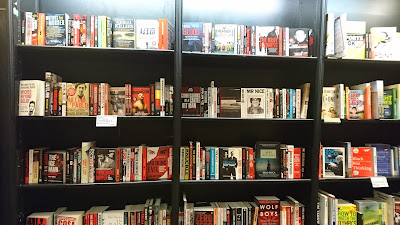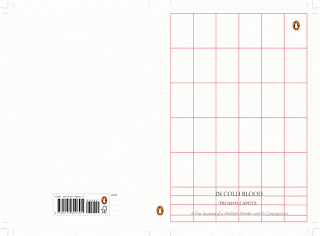This was a design
inspired by the Turkish silhouette cover. The two mean are looming
shadows across the Clutter family home. The small addition of orange
is to signify they were inside and completely unaware of the danger
outside. Although this has worked fairly well in creating a modern
approach to the story, the use of 'image trace' to create these
designs seems lazy and a common approach. In order to create
something original, each element of the figure/design needs to have
been considered. These outlines appear ominous with their faces half
in shadow, however that was just a fortunate result of editing. For
this competition they are looking for clever, elemental responses
that break the surface of each story.

This design was to use
some research on Richard Hickock who had a head injury as a result of
an automobile accident. Some suggest this was the cause of some of
his mental health problems and this design explores the link between
his facial disfigurement and his desire to murder. Of course this
could be considered offensive in some ways, so I have tried to make
it so extreme it cannot be linked with reality. The author's name has
been placed upside down in order to the show how his story ran
parallel to the killers and the project effected his own mental
health. The red outline is to suggest Dick's original self is trapped
in all these obscure identities.
One issue with it is
that it only includes Dick and not Perry, so perhaps if I was to
explore the back cover Perry could be placed on there. He also
suffered injuries in his troubled past, including leg disfigurement
which could have been illustrated as two legs standing next to the
blurb. Although this design has potential, it is very similar to many
other books on the market. The black, white and red aesthetic is
common and the sharp vector illustrations accompanied with bold type
has been done before. One thing that has been unexplored is the
extreme distortion, many designs are usually not stretched or pulled
in risk of looking careless, yet this deliberate approach might be
more successful.

This collage uses a
painting Perry Smith did on death row of Jesus, which has been
spliced with an image of Perry Smith's mugshot. This is to create
quite a new angle on Perry and give some insight into his complex
personality. He was quite an artistic, thoughtful individual, who
perhaps if he had been raised in different circumstances could have
lived a very different life. In some respects the story focuses on
his misfortune and how Dick is able to lead him into this situation.
One of the last
things he wrote was a poem about his search for human ties, including
'Perhaps
my eyes shall never reach, The light of freedom's skies.' This shows
his guilt, which I have highlighted by the juxtaposition with Jesus.
Only Perry has been included as he was the killer and was more
emotionally deluded and driven than Dick. I hope to develop this
cover with a serious, bible-like aesthetic; with simplistic, sans
serif type.

There
was also an experiment with overlaying the image with Jesus, so they
could create a new warped image. Although this did look creepy, the
intent of the image was less clear and the hand produced work of the
previous design felt more natural than the overly edited design here.

Whilst
watching the 1967 film there was a monologue at one point about how
tattoos are the equivalent of police badges and club patches, because
they signify belonging to a group/ having an identity. I thought It
would be interesting to convey this by having a row of arms, each
linking to someone in the story, all containing a symbol. Tattoos for
the killers, Kansas Police badge for the captors, a farm logo for the
Clutter family and Capote's signature or pen brand. This has not been
developed past sketches because it seemed like a complex task that
would require extremely good editing skills. Within the time limit I
don't think I could have produced this well without making it very
illustrative and drawing based.
Another
idea similar to this was to have a patch of tattooed skin look as if
it was sewn onto a police officer's uniform. However this may have
looked too grotesque, putting off some of the market.































